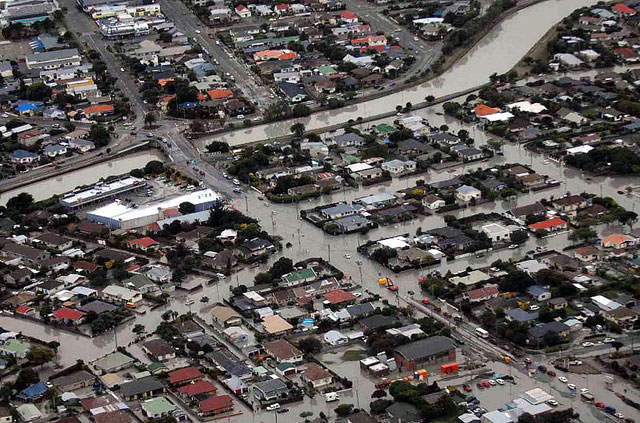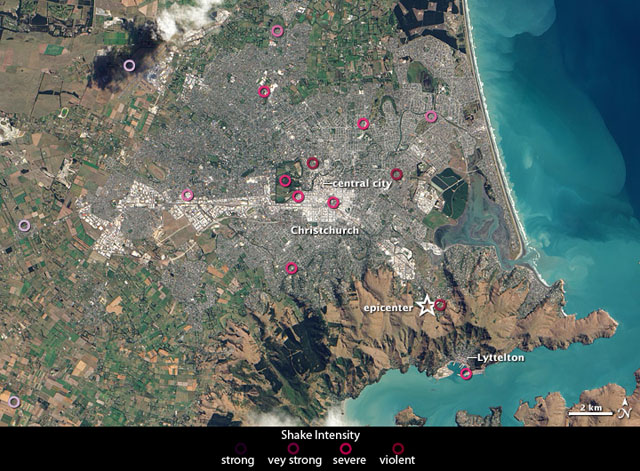Shifting through the piecesNSF funds RAPID grants to study effects from New Zealand, Japan earthquakesPosted October 28, 2011
The devastating earthquakes that struck New Zealand and Japan earlier this year demonstrated that scientists still have much to learn about these catastrophic events. The National Science Foundation Eventually, the NSF funded 42 of these Rapid Response Research (RAPID) grants for a total of more than $2.5 million. About a dozen grants targeted investigations into various aspects of the Christchurch earthquake, from effects of soil liquefaction on the city’s infrastructure to human behavior following a major quake. On Sept. 4, 2010, a 7.1-magnitue earthquake rocked the New Zealand’s Canterbury region on the South Island, with much of the damage centered near Christchurch, the country’s second-largest city. Nearly six months later, on Feb. 22, a shallow aftershock of 6.3-magntitude devastated the city center and killed more than 180 people in the country’s fourth-deadliest disaster in history. Christchurch has been the main gateway to Antarctica for U.S. scientists since the modern research program began in the 1950s. Nearly 600 people associated with the U.S. Antarctic Program (USAP) About 15,000 earthquakes occur in and around New Zealand each year, with about 250 big enough to be felt, according to GeoNet Several of the NSF-funded projects to Christchurch were organized by the U.S.-based Earthquake Engineering Research Institute (EERI) The team, under the leadership of Mary Comerio Other members of the group covered social sciences related to the resilience of the community, lessons in the use of social media during and after the earthquake, and risk communication issues between the September and February events and after the February earthquake. “That the construction types are similar to those of the United States and other countries, and that the earthquake was located on an unmapped fault within 10 [kilometers] of the city center, make this one of the most significant earthquakes in recent years for code and standard development in the United States and internationally,” the researchers wrote in a preliminary report in EERI’s May newsletter. The team also noted, “As in the September earthquake, the liquefaction damage was dramatic and widespread. Some residential areas of Christchurch may not be rebuilt because ground deformations have left the areas prone to flooding.” The statistics from news media are grim: About 1,000 of 4,000 buildings in the central business district have an appointment with a wrecking ball. In addition, about 10,000 homes will reportedly have to be demolished, with more than 100,000 damaged. Several New Zealand government agencies relocated to the USAP office space near the Christchurch Airport after the Feb. 22 quake. USAP staff in Christchurch also spent months recovering luggage left behind by USAP participants in damaged hotels and other accommodations. While the destruction to the city was tremendous and widespread, the psychological damage to the populace was also extensive, according to the researchers.
“After all the damage and psychological distress from both quakes, the public trust in all buildings within the heavily damaged area was shaken,” the researchers summarized. “The University of Canterbury NSF-funded research in this article: Jay Berger, Earthquake Engineering Research Institute, Award No. 1132381; Thomas Jordan, University of Southern California, Award No. 1136469; Rowena Lohman, Cornell University, Award No. 1137201; Yong-Gang Li, University of Southern California, Award No. 1137632; Jonathan Bray, University of California-Berkeley, award No. 1137977; Jose Restrepo, University of California-San Diego; Award No. 1138358; Roberto Leon, Georgia Tech, 1138609; Michael Lindell, Texas A&M, Award No. 1138612; Arturo Schultz, University of Minnesota-Twin Cities, Award No. 1138614; Amit Kanvinde, University of California-Davis; Award No. 1138634; Henri Gavin, Duke University, Award No. 1138714; and Jeannette Sutton, University of Colorado at Colorado Springs, Award No. 1138901. |



For USAP Participants |
For The Public |
For Researchers and EducatorsContact UsU.S. National Science FoundationOffice of Polar Programs Geosciences Directorate 2415 Eisenhower Avenue, Suite W7100 Alexandria, VA 22314 Sign up for the NSF Office of Polar Programs newsletter and events. Feedback Form |



